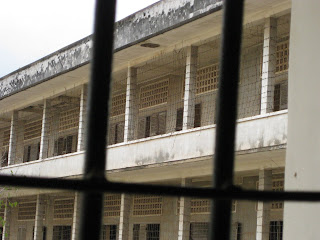WARNING: The rest of this entry contains graphic information
They said the time was year zero, and everything from the past needed to be erased. They then emptied the main city of Phnom Penh, (where we are currently) which had about 3 million people at the time. They sent everyone to go work in the fields and harvest rice. They had borrowed heavily from the Chinese and now had to pay them back with rice. Money, marketplaces and everything advanced was destroyed. Owning any kind of material things were not allowed, the penalty was death. Thousands starved and families were separated, and everyone was terrified about saying absolutely anything.
We have visited some sobering sights in the past few days. We went to the Tuong Sleng Museum, Also called S-21.
It was once a high school but under Pol Pot and the Khmer Rouge, it was used for torture and execution of prisoners. Anyone who was a suspect was brought here, and were made to confess to their “crimes”. The method of choosing the victims was quite crazy. Anyone who had any schooling, or any “western association” (wearing a watch or speaking any language other than Khmer) were automatically targeted. Anyone who spoke out against, or was considered a threat to, the rule of Angkar (what they called the new rule) were executed or sent to fatal work camps. Men, women and even children of all ages were victims. Here are three mug shots of some of the accused.
The prison is very much in the same state as it was during the reign of the Khmer Rouge. Many of the smaller classrooms were used a prison cells, and torture chambers. It was eerie to be there. But I feel compelled to write about it. I did not know. I fear that probably many of you do not know about this either. It is of a graphic nature, but how can people help if we are unaware? We may think ignorance is bliss, but truth reigns supreme.
We also went to “The Killing Fields”. It was the extermination camp and mass burial grounds of the S-21 prison. It was pretty horrible. It’s like attending a funeral, but worse. After you enter the grounds, there is a monument (or stupa) to remember those who were killed. Inside the glass cases are skulls.
Thousands of human skulls.
It really hits you in the face when you see it for yourself and up close like that.
Yet Cambodia is a nation of contradiction. As we were walking around the grounds, rain coming down, recollecting about the carnage that took place here, there’s a boy of about 14 walking ahead of us singing out loud, with no apparent concerns.
It weighs heavy on us. It is tragic that human beings can do such things to each other. If you’re still reading, and want to be more informed, there’s some books you can read. “First they killed my father” by Loung Ung. It is her personal story of what happened when she was a child. Also, “Voices from S-21” by David Chandler. There’s also the movie “The Killing Fields”. It came out in 1984 and is based on the story of an American’s journalist who was there at the start of the revolution, and the story of his close friend and helper who was Cambodian.
In 1998, Pol Pot, the leader of the “revolution” died before any justice could be done. His second in command also died before any type of justice could be served. Sadly, this seems like the norm without anything being done officially to give closure, by way of trials or a tribunal.
During that time, millions of landmines were planted in the fields and country sides. This is still a very relevant problem as they estimate there are about 4-6 million active landmines still abroad. On average, about 40 people are injured weekly due to landmines. We have been advised, and followed, to not stray from any paths. All around you see many victims who have lost limbs or been badly burned. We also visited the landmine museum a few days ago. It is run by “Aki Ra”, a former child soldier who’s job it was to deposit the landmines. He now uses his experience in the field to locate and disassemble landmines. Commendably the Canadian government has been quite involved in the abolition of personnel land mines, and their use throughout the world.
Yes, this is explicit, but it IS what happened. We can easily choose to ignore it, just as much of our world has done. Or we can educate ourselves and do something about it. Even telling someone else about it is something! The people who are hurting, starving, and dying around the world are very real; As real as each of us are to each other.






4 comments:
very sobering, I can't remember hearing about it, but that shouldn't stop us from doing our part now. Thanks for sharing.
mom
I knew about this from seeing the movie years ago. It wasn't until we went there in 2002 that the realization hit me! The whole time we were in Cambodia I felt very sick to my stomach. Experiencing the country has changed me as a person. Travel safe you 2. Gina
What a sad history. I had never heard about it so I appreciate you telling us. Mom
We just heard about this last year...thanks for sharing the pictures and all the information... take care as you see and experience difficult things like this...
Post a Comment